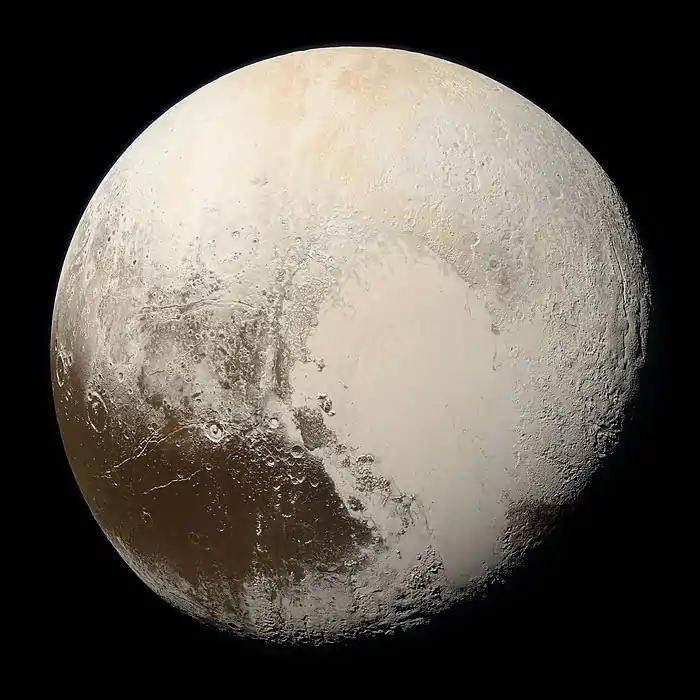(42301) 2001 UR163
(42301) 2001 UR163, provisional designation 2001 UR163, is a resonant trans-Neptunian object and possible dwarf planet located in the outermost region of the Solar System. It was discovered on 21 October 2001 by astronomers of the Deep Ecliptic Survey program at Kitt Peak National Observatory near Tucson, Arizona, United States.[1] The object measures approximately 600 kilometers in diameter and stays in an orbital resonance with Neptune (4:9). It has the reddest color of any object in the Solar System.
 Hubble Space Telescope image of 2001 UR163 taken in 2005 | |
| Discovery [1][2] | |
|---|---|
| Discovered by | DES |
| Discovery site | Kitt Peak National Obs. |
| Discovery date | 21 October 2001 |
| Designations | |
| (42301) 2001 UR163 | |
| 2001 UR163 | |
| TNO [3] · 4:9 res [4] distant [1] | |
| Orbital characteristics [3] | |
| Epoch 4 September 2017 (JD 2458000.5) | |
| Uncertainty parameter 2 | |
| Observation arc | 34.26 yr (12,515 days) |
| Aphelion | 65.948 AU |
| Perihelion | 36.682 AU |
| 51.315 AU | |
| Eccentricity | 0.2852 |
| 367.60 yr (134,267 d) | |
| 79.249° | |
| 0° 0m 9.72s / day | |
| Inclination | 0.7528° |
| 301.71° | |
| 342.36° | |
| Physical characteristics | |
Mean diameter | 531.5 km (derived)[5] 585 km[6] 671 km[7] |
| 0.09 (assumed)[7] 0.10 (assumed)[5] 0.10[6] | |
| RR-U [8] · C [5] Super red B–V = 1.250±0.110[8] V–R = 0.880±0.060[8] V–I = 1.540±0.160[8] | |
| 21.3[9] | |
| 3.75±0.05[10] 3.812±0.109 (R)[11] 4.1[3] · 4.4[6] · 4.49[5] 4.49±0.06[12] 4.71±0.06[13] | |
Classification and orbit
2001 UR163 has been characterized as a dwarf-planet candidate.[14] Based on assumptions and estimates, Michael Brown gives it a "likely"-status on his website, which is the third highest status after "near certainty" and "highly likely" (also see his classification table).[6]
The object orbits the Sun at a distance of 36.7–65.9 AU once every 367 years and 7 months (134,267 days; semi-major axis of 51.3 AU). Its orbit has an eccentricity of 0.29 and an inclination of 1° with respect to the ecliptic.[3] It came to perihelion around 1937.[3] In 2006, it moved beyond 50 AU from the Sun and is at 53 AU as of 2018.[9]
The body's observation arc begins with a precovery, published by the Digitized Sky Survey and taken at the Siding Spring Observatory in July 1982.[1]
Physical characteristics
Lightcurve analysis shows only small deviations, suggesting that 2001 UR163 is a spheroid with small albedo spots.[15]
Diameter and albedo
Based on estimates published on Michael Brown's website and by the Lightcurve Data Base and the Johnston's archive, 2001 UR163 measures between 531 and 671 kilometers, based on an assumed intermediate surface albedo of 0.09 to 0.10.[5][6][7]
Naming
As of 2018, this minor planet has not been named.[1]
See also
- List of Solar System objects most distant from the Sun in 2015
References
- "42301 (2001 UR163)". Minor Planet Center. Retrieved 1 February 2018.
- Marsden, Brian G. (14 November 2001). "MPEC 2001-V57: 2001 QX322, 2001 UR163, 2001 VN71". IAU Minor Planet Center. Harvard-Smithsonian Center for Astrophysics. Retrieved 6 January 2010. (K01UG3R*)
- "JPL Small-Body Database Browser: 42301 (2001 UR163)" (2016-10-31 last obs.). Jet Propulsion Laboratory. Retrieved 1 February 2018.
- Marc W. Buie (23 October 2003). "Orbit Fit and Astrometric record for 42301". SwRI (Space Science Department). Retrieved 25 September 2008.
- "LCDB Data for (42301)". Asteroid Lightcurve Database (LCDB). Retrieved 1 February 2018.
- Michael E. Brown. "How many dwarf planets are there in the outer solar system? (updates daily)". California Institute of Technology. Retrieved 31 August 2016.
- Johnston, Wm. Robert (30 December 2017). "List of Known Trans-Neptunian Objects". Johnston's Archive. Retrieved 1 February 2018.
- Belskaya, Irina N.; Barucci, Maria A.; Fulchignoni, Marcello; Dovgopol, Anatolij N. (April 2015). "Updated taxonomy of trans-neptunian objects and centaurs: Influence of albedo". Icarus. 250: 482–491. Bibcode:2015Icar..250..482B. doi:10.1016/j.icarus.2014.12.004.
- "AstDyS (42301) 2001UR163 Ephemerides". Department of Mathematics, University of Pisa, Italy. Retrieved 1 February 2018.
- Sheppard, Scott S.; Jewitt, David C. (June 2003). "Hawaii Kuiper Belt Variability Project: An Update". Earth. 92 (1): 207–219. Bibcode:2003EM&P...92..207S. doi:10.1023/B:MOON.0000031943.12968.46.
- Peixinho, N.; Delsanti, A.; Guilbert-Lepoutre, A.; Gafeira, R.; Lacerda, P. (October 2012). "The bimodal colors of Centaurs and small Kuiper belt objects". Astronomy and Astrophysics. 546: 12. arXiv:1206.3153. Bibcode:2012A&A...546A..86P. doi:10.1051/0004-6361/201219057.
- Santos-Sanz, P.; Ortiz, J. L.; Barrera, L.; Boehnhardt, H. (February 2009). "New BVRI photometry results on Kuiper Belt Objects from the ESO VLT". Astronomy and Astrophysics. 494 (2): 693–706. arXiv:0812.4525. Bibcode:2009A&A...494..693S. doi:10.1051/0004-6361:20078301.
- Perna, D.; Barucci, M. A.; Fornasier, S.; DeMeo, F. E.; Alvarez-Candal, A.; Merlin, F.; et al. (February 2010). "Colors and taxonomy of Centaurs and trans-Neptunian objects". Astronomy and Astrophysics. 510: A53. arXiv:0912.2621. Bibcode:2010A&A...510A..53P. doi:10.1051/0004-6361/200913654.
- Gonzalo Tancredi & Sofía Favre (13 October 2008). "Dwarf Planet & Plutoid Headquarters". Portal Uruguayo de Astronomía. Retrieved 22 September 2010. (Which are the dwarfs in the Solar System?)
- Tancredi, G., & Favre, S. (2008) Which are the dwarfs in the Solar System?. Depto. Astronomía, Fac. Ciencias, Montevideo, Uruguay; Observatorio Astronómico Los Molinos, MEC, Uruguay. Retrieved 10-08-2011
External links
- List Of Centaurs and Scattered-Disk Objects, Minor Planet Center
- The Meudon Multicolor Survey (2MS) of Centaurs and Trans-Neptunian objects
- TNO Colors
- KBO Surface Colors
- Red Planetoid Sedna covered in tar-colored sludge
- Asteroid Lightcurve Database (LCDB), query form (info)
- Discovery Circumstances: Numbered Minor Planets (40001)-(45000) – Minor Planet Center
- (42301) 2001 UR163 at AstDyS-2, Asteroids—Dynamic Site
- (42301) 2001 UR163 at the JPL Small-Body Database

_(cropped).jpg.webp)
